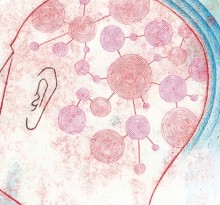Childhood anesthesia may thwart the development of third molars

Above left, the skull of a normally developing 5-year-old. Only primary molars have erupted. The circle shows where permanent molars are developing. Above right, a close-up view showing the unerupted permanent first molar (arrow A), the permanent second molar deep in its bony crypt (arrow B) and the developmental area for the third molar (arrow C). Photo: Swee J, Silvestri AR and colleagues. Inferior alveolar nerve block and third-moLar a genesis. A retrospective clinical study. JADA 2013;144(4):389-95. Copyright ©2013 American Dental Association. All rights reserved. Reprinted with permission.
Extracting a wisdom tooth is no small deal. The procedure involves anesthesia, surgery, lost time from work and—of course—an uncomfortable recovery.
“When you talk to people or patients, the words ‘wisdom tooth’ create emotion,” says Anthony Silvestri, E69, a clinical professor of prosthodontics and operative dentistry at Tufts. “It’s kind of a hot-button topic.
“Removing wisdom teeth requires invasive surgery, which has its complications and dangers,” he says. “Things can go wrong. It’s rare, but even deaths have happened.” According to the American Association of Oral and Maxillofacial Surgeons (AAOMS), roughly one in 365,000 people is fatally or seriously injured by oral local and general anesthetics each year.
The association also reports that nine out of 10 people suffer from at least one impacted wisdom tooth at some point in their lives. The remaining 10 percent either have wisdom teeth that grow in without complication, or—better still—no wisdom teeth at all, effectively letting them dodge the surgical bullet.
At first glance, it seems those few patients without third molars have luck, or maybe genetics, on their side. But according to a study by Silvestri and pediatric dentist Jerry Swee, D05, DG11, a child’s dentist may play an inadvertent role in this good fortune. In a paper published in the Journal of the American Dental Association in April, Silvestri and Swee reported that routinely administered local oral anesthesia injections for the lower jaw might be stopping some wisdom teeth from developing in the first place.
Unlike other teeth, Silvestri says, third molars don’t start to develop until a child is between 2 and 6 years old, when four tiny tooth buds form at the back corners of the mouth. On the lower jaw, these buds are just millimeters away from where dentists deliver local anesthetics to the inferior alveolar nerve in order to numb the lower teeth. If a needle accidentally penetrates the developing bud, it might cause enough damage to the delicate tissues to stop tooth growth in its tracks, Silvestri says.
“I think that many dentists don’t realize this, but the initial development of a wisdom tooth is happening just below the soft tissues on the surface of bone, so it’s potentially very susceptible to trauma,” he notes.
To test their theory, Silvestri and Swee examined dental X-rays of more than 200 patients under age 12, looking at sites where wisdom tooth buds usually develop, at the rear of the lower jaw. For patients who had never received local anesthesia, X-rays showed a missing wisdom tooth in 1.9 percent of those sites. In patients who did receive an injection, though, the number of missing wisdom tooth buds jumped to nearly 8 percent, which, the authors say, indicates a strong statistical association between delivering local anesthesia to the lower jaw and the development of wisdom teeth.
“When Jerry Swee presented the results of this research to other dentists, the reaction was almost universal disbelief,” says Silvestri. “Very few people thought that there would be a statistical correlation. But if you understand how and where the wisdom tooth develops, it makes total sense.”
A ‘Cure’ for Wisdom Teeth?
It may seem like a happy accident that nipping a wisdom tooth in the bud—literally—hinders its growth, but Silvestri has been researching the concept for more than 25 years. He’s done animal research to develop a non- or minimally invasive way to stop wisdom teeth from growing. If a dentist can stop the wisdom tooth from forming in the first place, he says, it may help patients avoid surgery down the road.
Silvestri is also quick to point out that the theory needs further study. “One of our mottos as medical providers is ‘do no harm,’ and therefore much work needs to be done to ensure that any new technique performed in children is totally safe,” he says. “Yet the fact that dentists may have been stopping wisdom teeth from growing for nearly 100 years without even knowing it gives much hope that a preventive technique to intentionally stop wisdom teeth could be developed.”







